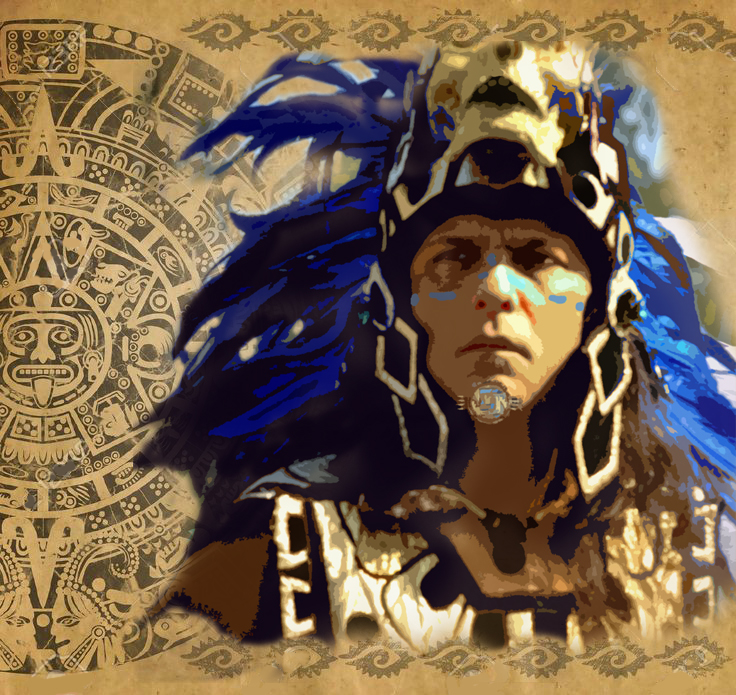
Cuitláhuac was the 10th emperor of the Aztec Empire.A council of noblemen chose him to be Great Speaker in 1520 after an angry crowd of Aztecs killed the previous emperor for collaborating with the Spaniards.His reign lasted only a brief time before he died in a smallpox epidemic in the same year he became emperor.
Cuitláhuac has the distinction of being the only Aztec emperor to defeat the Spaniards in battle, as his successor Cuauhtémoc suffered total defeat at the hands of the invaders.
Cuitláhuac was born in 1476 and came from a noble lineage. He was the son of the sixth Aztec emperor, Axayacatl, and the brother of the ninth Aztec emperor, Montezuma II. As a member of the royal governing family, Cuitláhuac played an important role in governing and administering the tribute and alliance system of the Aztec Empire. His brother Montezuma entrusted him with diplomatic missions and sensitive negotiations after becoming emperor. Montezuma also appointed him lord of the important city of Ixtalpalapan before the Spaniards arrived in Aztec territory.
Emperor Montezuma held a conference of noblemen after the first news of the Spaniards reached the capital city, Tenochtitlán. At that meeting and on other occasions, Cuitláhuac forcibly argued that Montezuma should use any means to prevent the entry of the Spaniards into the Aztec island capital. He became one of the main proponents of fighting the Spaniards, including a failed assault at the town of Cholula in 1519, which resulted in a Spanish massacre of the townspeople.
In November 1519, Spanish conquistador Hernando Cortés entered the valley of Mexico and arrived at Tenochtitlán. Montezuma, against the advice of Cuitláhuac, arranged a meeting with Cortés. Cuitláhuac attended the meeting as one of the representatives of the Aztec nobility. He and his brother strongly disagreed on the nature of the Spanish leader. Montezuma believed that Cortés was the incarnation of the Aztec god Quetzalcóatl (Plumed-Serpent).
The Aztec religion believed that Quetzalcóatl, described as having hair as gold, would return to Tenochtitlán after traveling across the seas.The blonde-haired Cortés matched that description. Cuitláhuac and many other Aztec nobles, however, did not share Montezuma’s belief in the Spaniard’s divinity and remained suspicious of the heavily armed strangers.Their suspicions proved valid when Cortés took Montezuma, Cuitláhuac, and a large number of important nobles captive a short time after entering the city.Cortés kept them prisoners in the palace of Axayactl, which the Spaniard had turned into his headquarters while in Tenochtitlán.
In May 1520, Cortés had to return to the coast to fight a rival Spanish captain sent to arrest him. In his absence, his designated commander, Capt. Pedro de Alvarado, slaughtered a large number of Aztec nobles celebrating a ritual festival in a manner that he found offensive.
Cortés returned to a tense city with reinforcements but quickly found himself under serious attack. The Aztecs besieged the Spanish headquarters. At Montezuma’s request, Cortés set Cuitláhuac free in order to appease the enraged Aztecs. This possibly represented Montezuma’s last-minute plan to right his mistakes and ensure strong leadership for his people. As soon as he was freed, Cuitláhuac directed the military assault against the Spaniards.
A council of noblemen named Cuitláhuac as Great Speaker of the Aztecs after the death of Montezuma. The Spaniards had forced Montezuma to the roof of their headquarters and ordered him to stop the Aztec attacks. The Aztecs responded with a hail of rocks, which killed their reviled emperor. Cuitláhuac had never trusted the Spaniards, and he began to organize for full war with the help of his nephew Cuauhtémoc.
Cuitláhuac moved to enlist more troops and maintain allies in an effort to defeat the Spaniards. The Aztecs’ greatest victory came on June 30, 1520 when Cuitláhuac directed the battle that forced the Spaniards from Tenochtitlán. A powerful force of 100,000 Aztec warriors routed the Spaniards and decimated Cortés’ army, forcing them to retreat from the city into the lands of their Tlaxcaltecan allies. That night became known as La Noche Triste, or The Sad Night, in which the Spaniards suffered many casualties and lost control of Tenochtitlán.
Cuitláhuac’s immediate task as new emperor involved building and maintaining alliances with the cities and towns around the island city of Tenochtitlán. He also had to ensure the loyalty of tribute-paying regions and prevent defections to the Spaniards. Aztec rulers appointed by Montezuma and Cortés as puppets had to be replaced with loyal officials.
A series of tributary rebellions forced Cuitláhuac to divide his forces in order to consolidate his power. This weakened his army and prevented him from launching an offensive when the Spanish were at their weakest. His greatest failure came from his inability to convince the powerful city of Tlaxcalteca to break its alliance with the Spaniards.
Cuitláhuac’s reign, however, lasted only 80 days before he died in a smallpox epidemic that raged through Tenochtitlán. The Aztecs had captured a number of Spaniards and Tlaxcaltecans during battle, and the prisoners were then sacrificed to the war god Huitzilopochtli.
According to several sources, one of the prisoners carried the smallpox virus, which spread quickly spread after the Aztecs consumed him in a cannibalistic ritual. Cuitláhuac, as emperor, was one of the first to consume the flesh of his enemies in a religious ceremony. In October 1520, Cuitláhuac died, leaving his nephew Cuauhtémoc to lead the final battle against the Spanish as the last of the Aztec emperors.

